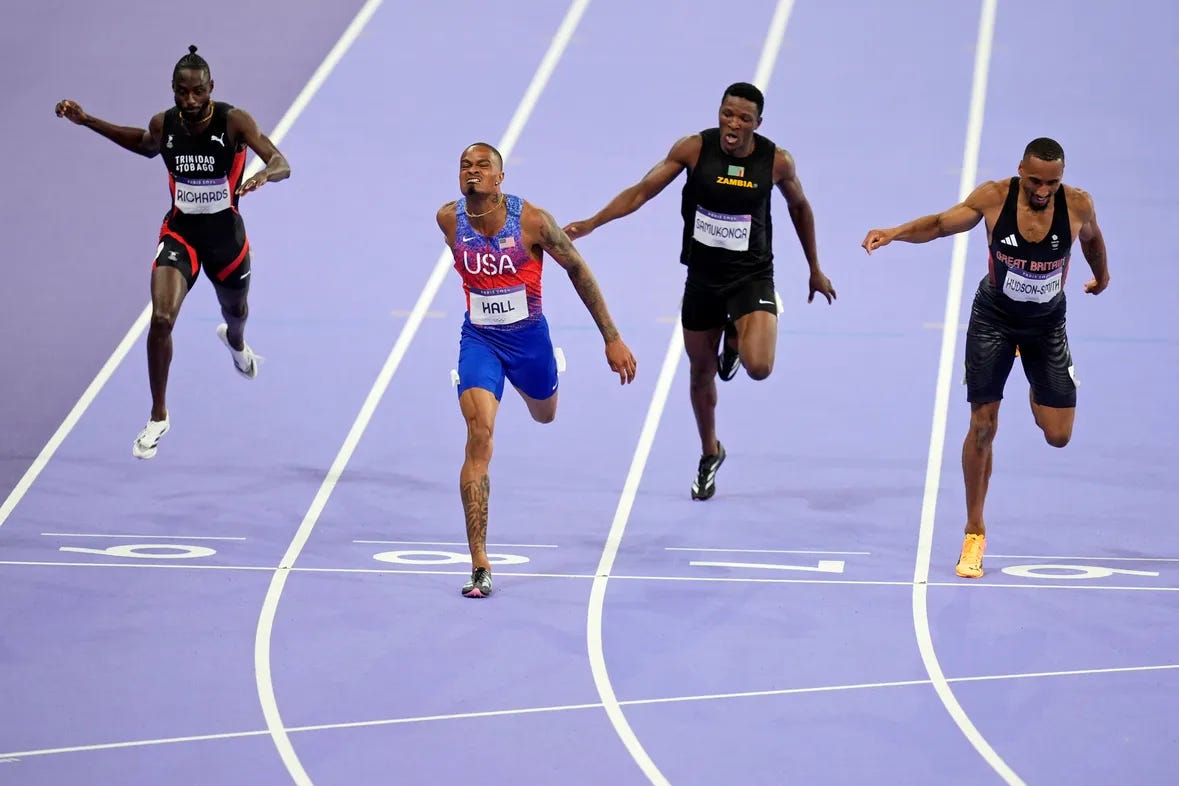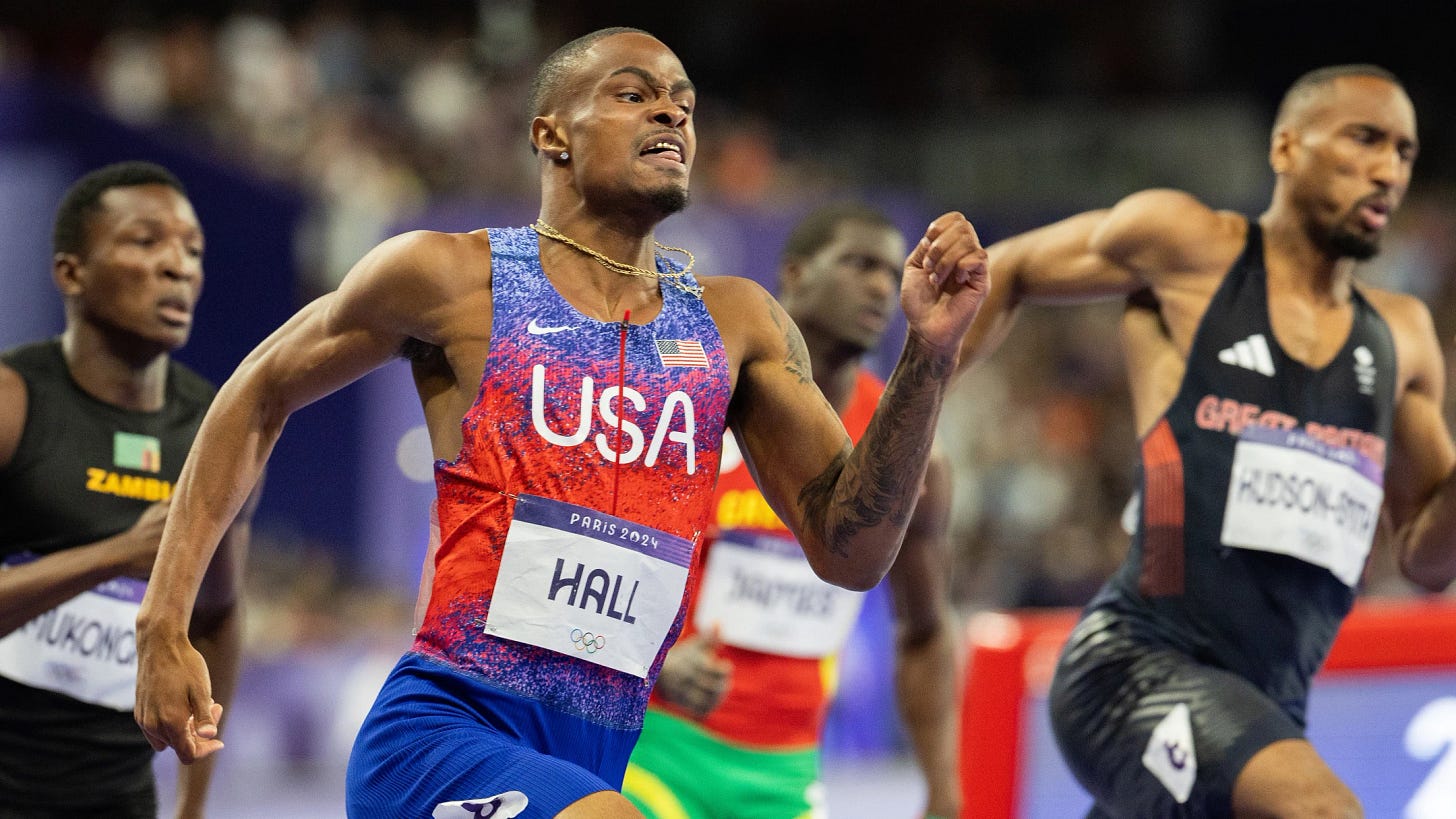There is no "kick" in the 400m and Quincy Hall proved it
400m Olympic Final, World Records, and what it takes to really win
Paid Subscribers: Send me a message with your pre-season questions or 400m race strategy and I’ll get back to you! I’ll respond to everyone by Sept 13!🙋♀️🙋♂️
“Quincy Hall finds another gear!”
“Quincy Hall’s incredible charge to the finish!”
“Hall kicks for Olympic Gold!”
If you watched the men’s 400m Olympic Final earlier this month then you might have read or heard quotes like that⬆️ The Olympics brought the best out of many athletes and the men’s 400m was no exception. The men’s 400m was the fastest overall final in Olympic history with five men going under 44.90. The top four athletes hit lifetime personal bests. Quincy Hall at 43.40 hit the 5th fastest performance of all time. After the race, I heard and read about his “kick” over the last part of the race. He certainly wasn’t leading at 200m and 300m, but he was never out of it. And he’s always been able to finish a race (notice I didn’t say “kick”.) We can’t think that the ONLY thing that made him an Olympic Champion was his “kick”, as it has been famously labeled.
In fact…it was not a kick at all.
Several things from social media caught my attention after the race:⬇️
People talked like he was an underdog
Some people labeled him “the underdog” like he wasn’t a major contender from the get-go. That’s a little bizarre considering Quincy had the second fastest time in the world going into the Olympic Games. And it was by a very small margin. Three weeks before the Olympics, Hall went 43.80. Compared to Hudson-Smith—the world leader—who was 43.74 that’s a .06 difference. That’s less than a step🏃 different.
Some said he was totally out of the race at 200m
He was absolutely in the race at 200m and 300m. At 200m, Hall was at 21.00s while half of the field was at 20.46 to 20.95. He was well within striking distance.
Social media said it’s not his speed, it’s his “strength”
Let’s be real. Yes, he has “strength” but more importantly he has speed. His professional career doesn’t label him as a “speed guy” because Quincy hasn’t run many 200m races in his life. But going out in 21.00 proves he has speed. You can’t go out in 21.00 if you don’t have at least 20.50 speed and he definitely wouldn’t be able to finish the race and win without speed. At age 17, in high school, Quincy’s 200m PR was 21.65…the man has genetic speed. That time is not OMG, but it is fast for a 17 year old that ran limited 200m races.
Look at that “kick!”
I am sorry to inform you…he did not “kick.” The final 100m of his race was the slowest of his race by far. He was decelerating rapidly. More on this later.⬇️
He ran cross country in high school so he had “strength” to finish the race
Um no. No correlation. Maybe cross country taught him to be mentally tough and/or learn to work through fatigue better than others. And that’s a BIG maybe. But there are no significant gains from running cross country in high school that helped him sprint 43.40 and become the 400m Olympic Champion as a 26 year old.
There is no such thing as a “kick” in the 400m
None. Notta. Nope. The term “kick” comes from distance races where athletes literally increase their speed to finish. It comes after pacing a race and it means that a runner has increased speed, pace, and frequency to finish faster, and the clock supports that. The runner’s last 200m or last 400m is actually faster than the previous parts of the race. That does not exist in elite 400m races. It just doesn’t. EVERYONE is decelerating, it’s just a matter of who can mentally, emotionally, and physically keep it together the best. The goal is to decelerate the LEAST amount through fatigue and lactic acid. Quincy Hall did THAT while putting his chin up and gritting his teeth.
The goal is to decelerate the LEAST amount through fatigue and lactic acid.
I gave a presentation at the 2019 USTFCCCA National Coach’s Convention titled “Maximizing Potential in the 400m” based on knowledge and experience from my career as a high school and collegiate coach. One of the key phrases in my presentation was, “Most people set new personal bests by running faster in the first half of the race, NOT by finishing faster.” As I compared Wayde Van Niekerk’s world record to the previous world record holder Michael Johnson, it was clear how important speed is in the first half of the race.
As shown below, Wayde Van Niekerk ran significantly faster than Johnson in the first 200m. Then ran significantly slower than Johnson in the second 200 meters, yet still overtook the world record. Wayde Van Niekerk, in fact, overtook the world record in the first 200m of the race. Both athletes decelerated significantly during their race.
Find speed by racing 200m
Because of the importance of the first 200m in the 400m race, I believe it is essential to race some 200s. There are two important reasons to do so. The first reason is to have a benchmark of where an athlete’s speed is. It is important to me because I want to know how fast an athlete can and should go out in the 400m race.








